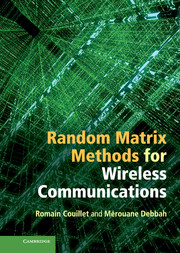Book contents
- Frontmatter
- Contents
- Preface
- Acknowledgments
- Acronyms
- Notation
- 1 Introduction
- Part I Theoretical aspects
- Part II Applications to wireless communications
- 11 Introduction to applications in telecommunications
- 12 System performance of CDMA technologies
- 13 Performance of multiple antenna systems
- 14 Rate performance in multiple access and broadcast channels
- 15 Performance of multi-cellular and relay networks
- 16 Detection
- 17 Estimation
- 18 System modeling
- 19 Perspectives
- 20 Conclusion
- References
- Index
12 - System performance of CDMA technologies
from Part II - Applications to wireless communications
Published online by Cambridge University Press: 07 October 2011
- Frontmatter
- Contents
- Preface
- Acknowledgments
- Acronyms
- Notation
- 1 Introduction
- Part I Theoretical aspects
- Part II Applications to wireless communications
- 11 Introduction to applications in telecommunications
- 12 System performance of CDMA technologies
- 13 Performance of multiple antenna systems
- 14 Rate performance in multiple access and broadcast channels
- 15 Performance of multi-cellular and relay networks
- 16 Detection
- 17 Estimation
- 18 System modeling
- 19 Perspectives
- 20 Conclusion
- References
- Index
Summary
Introduction
The following four chapters are dedicated to the analysis of the rate at which information can be reliably transmitted over a physical channel characterized by its space, time, and frequency dimensions. We will often consider situations where one or several of these dimensions can be considered large (and complex) in some sense. Notably, the space dimension will be said to be large when multiple transmit sources or receive sensors are used, which will be the case of multiple antenna, multi-user, or multi-cell communications; the complexity of these channels arises here from the joint statistical behavior of all point-to-point channel links. The time dimension can be said to be large and complex when the inputs to the physical channel exhibit a correlated behavior, such as when signal precoders are used. It may be argued here that the communication channel itself is not complex, but for simplified information-theoretic treatment, the transmission channel in such a case is assumed to be the virtual medium formed by the ensemble precoder and physical channel. Finally, the frequency dimension exhibits complexity when the channel shows fluctuations in the frequency domain, i.e. frequency selectivity, which typically arises as multi-path reflections come into play in the context of wireless communications or when multi-modal transmissions are used in fiber optics.
To respect historical progress in the use of random matrix theory in wireless communications, we should start with the work of Telatar [Telatar, 1995] on multiple antenna communication channels.
- Type
- Chapter
- Information
- Random Matrix Methods for Wireless Communications , pp. 263 - 292Publisher: Cambridge University PressPrint publication year: 2011



